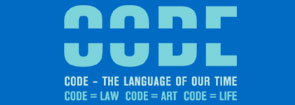| |
|
|
|
|
||
|
||||||||||||||||||||
| |
|
|
|
|
 |
|
 |
|||
| |
||||||||||
| |
||||||||||
 |
|
|||||||||
| |
||||||||||
| |
||||||||||
| |
||||||||||
| |
|
nybble-engine-toolZ: Distinction / Interactive Art
nybble-engine-toolZ by Margarete Jahrmann and Max Moswitzer is a "re-engineering" of an existing commercial system, of a game engine. The peer-to-peer software of the installation converts network processes into three-dimensional abstract movies. "A shooter is an established type of computer game in which it is a matter of sighting and shooting an object. nybble engine toolZ is a re-engineering of an existing commercial system, a game engine sprinkled with network commands. A nybble is the unit of half a byte or four bits and thus the basis of every digital conversion. As the numeric equivalent of the binary code, it exemplifies the internal logic of a software that converts codes and protocols on a server into various representations. nybble-engine-toolZ is a radical meta-art shooter, a self-ironic multi-player statement tool. Sensible from a cyber-ethical point of view, an anti-war email is commissioned with each shot made with the game pad in the installation and the online network. This email is displayed in real-time as both ASCII text and newly generated object. Out of this visually coded environment, text messages are sent. Commands can also be sent from the running engine to the network. With movements through the environment, trace routes are started from the game to a number of crucial government servers as are also inquiries to network connections. On the other hand, network activities outside the engine are displayed in the game environment in real-time as texts and 3-D objects. Emails can be sent into the environment and change it. By reversing the effects of a specific action, such as jump’n run or shoot, the rules of the game engine are turned round: the unreal tournament becomes a situationist détournement, an inversion. The installation: an interactive / interpassive group experiment Within the space itself another media change takes place. The architecture of the installation space where the participants take a seat is now shaped by the 3-D form of the virtual environment. Following contemporary architect and theorist Bernard Cache’s example, we call these forms objectiles. The peer-to-peer software of the installation converts network processes into three-dimensional abstract movies and projects these onto a 180-degree screen, such as experienced in an interpassive cinematic situation. The view of the machine in spectator mode—specifically of the server – is rendered. The network codes and commands are converted into audio-visual machinima movies, which is what films generated with the aid of game engines are called. Simultaneously they are playable command lines in a networked game environment. The participants in the experiment can, however, also become active in the installation space. At a small control desk they see their individual view of navigation, which presents a subjective perspective at variance with the server view on the screen. The players use an ordinary game pad to log onto the network of the installation and to enter into the shooter environment, where projectiles of data objects / data objectiles, action bots, in other words, artificial players with their own kinds of behaviour and minimal artificial intelligence, as well as other players are flying about. Each time a data-object is hit, network processes are triggered, each time a shot is fired with the game-pad, an anti-war email. There are two choices for the spectator, either to become a spect-actor or player who concentrates on the small Gameboy monitors and successfully navigates and influences what is happening on the big screen, or to be one whose attention fluctuates and combines the different perspectives – man’s and the machine’s. If one concentrates on one’s personal view, one influences the entire picture being simultaneously generated and projected. Seeing this simultaneous view of one running application in different windows might spur viewers to intervene in the communication which is also happening when no one is sitting in front of the installation. For then it is the action bots and online players that make the moves. Each bot or player’s avatar carries a data objectile instead of a weapon. These data objectiles represent command lines and processes. Laser-sintered by a printer, these data objectiles are also part of the installation’s interface. In its pure form as code equivalent and as discourse object it can be understood as both an interactive and interpassive object." (Margarete Jahrmann / Max Moswitzer) |  |
|
||||||
| |
||||||||||
| |
||||||||||
| |
 |
|||||||||
| © Ars Electronica Linz GmbH, info@aec.at | ||||||||||